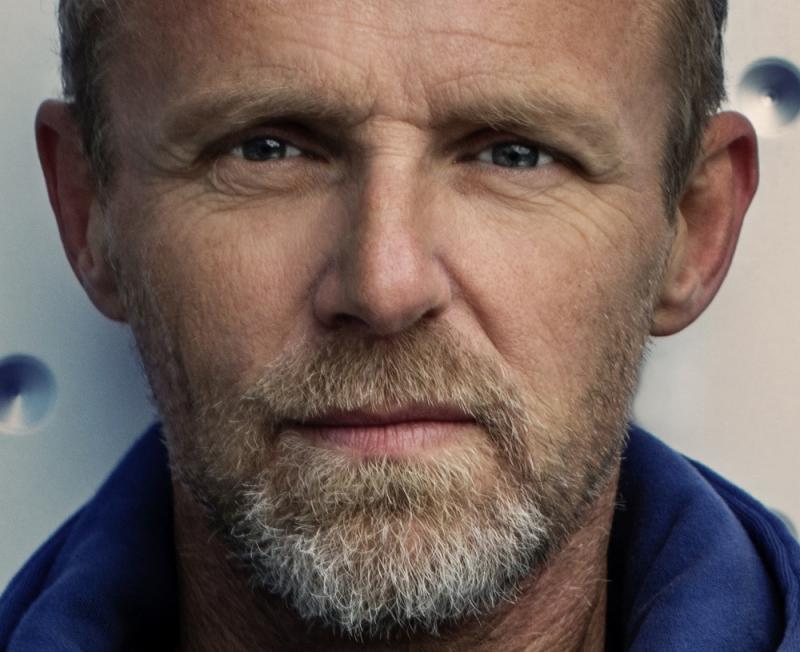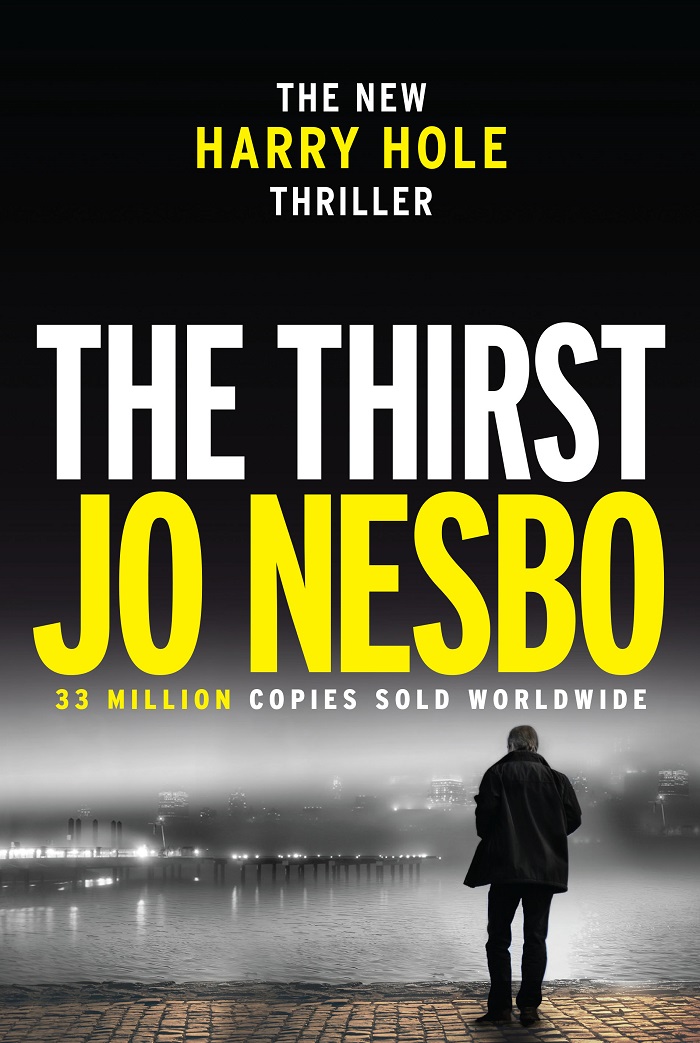Sunday Book: Jo Nesbo - The Thirst | reviews, news & interviews
Sunday Book: Jo Nesbo - The Thirst
Sunday Book: Jo Nesbo - The Thirst
The 11th case for Harry Hole is well worth sinking your teeth into

The jacket designs of Jo Nesbø’s Harry Hole thrillers don’t muck about. The novelist’s name with its anglicised spelling is branded in eye-catching upper-case yellow, accompanied by the latest sales figures. "Over five million copies sold worldwide" – that was several crime novels ago.
The Thirst arrives four years on from Police, and is sort of a sequel. In Police a series of policemen were killed by gruesome means. As is often the way with Hole’s cases, the perpetrator was hiding in plain sight: he was a colleague lecturing at the same police academy to which Hole had retreated having left the Oslo police department. The case was solved, but another killer roamed free: escaped convict Valentin Gjertsen, who on the last page of Police was on the brink of raping the pubescent daughter of his psychotherapist.
Gjertsen is still at large in The Thirst. He has been lying low, having undergone further facial surgery to make himself unrecognisable, but there’s no scrubbing away the lurid death-mask tattoo emblazoned on his chest. When a series of single women are murdered in their homes after Tinder dates, it doesn’t take long for a V signed in blood, as well as Valentin’s DNA, to show up at the crime scene. But Valentin’s lust for young flesh has transmuted into something altogether more bowel-shrivelling: a thirst for the blood of his victims, which he extracts by donning a set of iron jaws.
Hole would rather give the case a wide berth: his marriage to Rakel is going swimmingly, his alcohol addiction in abeyance while all his wounds, both psychic and physical, are apparently healed. But he’s soon blackmailed by the despicably ambitious Chief of Police Mikael Bellman – who calls him a predator, not a herbivore - to help catch the blood-sucking killer.
He’s keen to enlist his psychotherapist colleague Ståle Aune to help, but Aune is now a family man trying to coax his daughter Aurora through her miserable teenage years, little realising that it is she who was raped by Gjertsen. Step forward the garrulous Hallstein Smith, who is eager to use the killer’s specialist predilection to promote his theories about vampirism, which for lack of proof have hitherto found him ostracised from the psychology profession.
 The first death is what Hole calls “a could have been me murder”. This is an Oslo where men and women have outsourced the hunt for sex and/or romance to a dating app. Even Hole’s new boss Katrine Bratt – the Bergen cop who’s been on meds since going batshit bonkers in The Snowman - regularly swipes for shags. But the murders themselves are spectacularly lurid. The Thirst is another highly competent if thoroughly bonkers excursion into Nesbø’s sick brand of Nordic noir. Something about the high latitude induces grandiose Scandi villains into behavioural extremism – see also The Bridge.
The first death is what Hole calls “a could have been me murder”. This is an Oslo where men and women have outsourced the hunt for sex and/or romance to a dating app. Even Hole’s new boss Katrine Bratt – the Bergen cop who’s been on meds since going batshit bonkers in The Snowman - regularly swipes for shags. But the murders themselves are spectacularly lurid. The Thirst is another highly competent if thoroughly bonkers excursion into Nesbø’s sick brand of Nordic noir. Something about the high latitude induces grandiose Scandi villains into behavioural extremism – see also The Bridge.
With each novel there’s a sense in which Nesbø has to give himself a higher bar to clear. The Snowman, published a decade ago, recounted his tussle with Norway’s first serial killer. Since then he’s had nothing but serial killers to deal with. Nesbø peppers the narrative with entertaining tracts of psychological underpinning, There are contextualising allusions in The Thirst to Othello syndrome, the morality of meat-eating, and a particularly blood-curdling tribe of Native Americans. They may be steeped in deep research and may be utter baloney. But they're fun.
In the end the reason to come back for more is the sheer magnetism of Harry Hole. He detests being good at his job, but is unable to avoid utter commitment to it, for which the cost is high: there’s always someone close to him in grievous danger, and Hole is forever playing the sacrificial lamb who gives his blood and even expendable bits of his body to protect the public, and do honour to the victims. “The dead take priority over the living,” he says.
The Thirst like its stablemates is a bulky but zippy 500-pager which never loiters in one place for long. Nesbø keeps you guessing with his usual bag of tricks, making everyone seem a little suspect (or almost everyone). His cynicism about bent coppers and unscrupulous journalists is an inexhaustible and entertaining sideshow. Perhaps, and not for the first time, he gives a little too much credence to the fantasy that a psychopath can carry on his work while keeping up a plausible exterior. What that means is that two thirds of the way in it feels as if every bow has been satisfactorily tied up, but Hole can’t leave the case alone, triggering a climax of breakneck, baroque delirium.
In short, if you liked the other ten, you’ll greedily sink your teeth into this. And maybe by the time it appears in paperback many more millions will have been sold. Later this year Hole makes his big screen debut in the guise of Michael Fassbender, who is the right height but nothing like ugly enough. The Snowman is directed by Tomas Alfredson, who made Let the Right One In and Tinker Tailor Soldier Spy. It's about time Harry Hole became a movie star.
rating
Share this article
The future of Arts Journalism
You can stop theartsdesk.com closing!
We urgently need financing to survive. Our fundraising drive has thus far raised £49,000 but we need to reach £100,000 or we will be forced to close. Please contribute here: https://gofund.me/c3f6033d
And if you can forward this information to anyone who might assist, we’d be grateful.

Subscribe to theartsdesk.com
Thank you for continuing to read our work on theartsdesk.com. For unlimited access to every article in its entirety, including our archive of more than 15,000 pieces, we're asking for £5 per month or £40 per year. We feel it's a very good deal, and hope you do too.
To take a subscription now simply click here.
And if you're looking for that extra gift for a friend or family member, why not treat them to a theartsdesk.com gift subscription?
more Books
 'We are bowled over!' Thank you for your messages of love and support
Much-appreciated words of commendation from readers and the cultural community
'We are bowled over!' Thank you for your messages of love and support
Much-appreciated words of commendation from readers and the cultural community
 Robin Holloway: Music's Odyssey review - lessons in composition
Broad and idiosyncratic survey of classical music is insightful but slightly indigestible
Robin Holloway: Music's Odyssey review - lessons in composition
Broad and idiosyncratic survey of classical music is insightful but slightly indigestible
 Thomas Pynchon - Shadow Ticket review - pulp diction
Thomas Pynchon's latest (and possibly last) book is fun - for a while
Thomas Pynchon - Shadow Ticket review - pulp diction
Thomas Pynchon's latest (and possibly last) book is fun - for a while
 Justin Lewis: Into the Groove review - fun and fact-filled trip through Eighties pop
Month by month journey through a decade gives insights into ordinary people’s lives
Justin Lewis: Into the Groove review - fun and fact-filled trip through Eighties pop
Month by month journey through a decade gives insights into ordinary people’s lives
 Joanna Pocock: Greyhound review - on the road again
A writer retraces her steps to furrow a deeper path through modern America
Joanna Pocock: Greyhound review - on the road again
A writer retraces her steps to furrow a deeper path through modern America
 Mark Hussey: Mrs Dalloway - Biography of a Novel review - echoes across crises
On the centenary of the work's publication an insightful book shows its prescience
Mark Hussey: Mrs Dalloway - Biography of a Novel review - echoes across crises
On the centenary of the work's publication an insightful book shows its prescience
 Frances Wilson: Electric Spark - The Enigma of Muriel Spark review - the matter of fact
Frances Wilson employs her full artistic power to keep pace with Spark’s fantastic and fugitive life
Frances Wilson: Electric Spark - The Enigma of Muriel Spark review - the matter of fact
Frances Wilson employs her full artistic power to keep pace with Spark’s fantastic and fugitive life
 Elizabeth Alker: Everything We Do is Music review - Prokofiev goes pop
A compelling journey into a surprising musical kinship
Elizabeth Alker: Everything We Do is Music review - Prokofiev goes pop
A compelling journey into a surprising musical kinship
 Natalia Ginzburg: The City and the House review - a dying art
Dick Davis renders this analogue love-letter in polyphonic English
Natalia Ginzburg: The City and the House review - a dying art
Dick Davis renders this analogue love-letter in polyphonic English
 Tom Raworth: Cancer review - truthfulness
A 'lost' book reconfirms Raworth’s legacy as one of the great lyric poets
Tom Raworth: Cancer review - truthfulness
A 'lost' book reconfirms Raworth’s legacy as one of the great lyric poets
 Ian Leslie: John and Paul - A Love Story in Songs review - help!
Ian Leslie loses himself in amateur psychology, and fatally misreads The Beatles
Ian Leslie: John and Paul - A Love Story in Songs review - help!
Ian Leslie loses himself in amateur psychology, and fatally misreads The Beatles
 Samuel Arbesman: The Magic of Code review - the spark ages
A wide-eyed take on our digital world can’t quite dispel the dangers
Samuel Arbesman: The Magic of Code review - the spark ages
A wide-eyed take on our digital world can’t quite dispel the dangers

Add comment